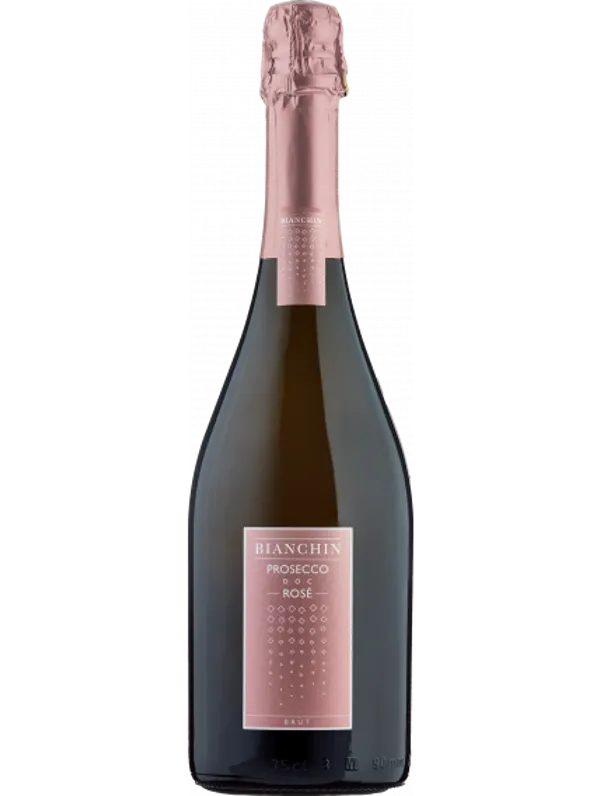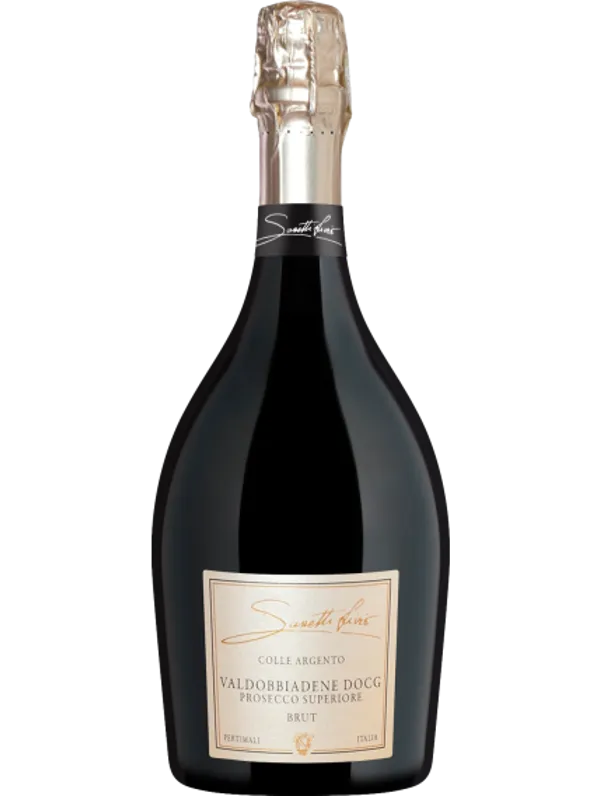Prosecco is the sparkling wine made from Glera grapes, primarily grown in the Veneto region of Italy, in the Prosecco DOC. The wine's name derives from the village of Prosecco near Trieste, the northernmost city in the Adriatic Sea. Known for its aromatic and crisp flavor profile, Prosecco is often used as an aperitif but is also versatile in cocktails and with various dishes.
Primary Flavors
Green Apple
Pear
Melon
Honey
Grape Profile
TANNIN: Quite Soft, Barely Noticeable Tannins
ACIDITY: High Acidity, Tangy and Crisp
BODY: Light to Medium, Versatile
SUGAR: Slightly Dry with a Hint of Sweetness
LEVEL OF ALCOHOL: Middle Range (9-12%)
Handling
Serve 3-7°C
Decant No
Glass Type Flute Glass
Period open1-3 days
Cellar Between 1 and 2 Years
Our Top selection

Ruggeri Prosecco Superiore Valdobbiadene Cartizze Brut NV
Elegant Prosecco with summer pear and white flower aromas. Vivid minerality and a zesty citrus finish.
Read more

Bianchin Asolo Prosecco Rose Brut
Bright pink Brut Rosé with peach and pomegranate notes. Velvety texture and refreshing acidity. Ideal with seafood.
Read more

Sassetti Livio Pertimali Colle Argento Valdobbiadene Prosecco Superiore Brut
Citrusy and floral Prosecco. Balanced acidity and a long finish. Pairs well with seafood and salty cheeses.
Read more

Valdobbiadene Prosecco Superiore Cartizze 'La Rivetta' Brut DOCG
Elegant 2016 Prosecco from Veneto, highlighting the best of Glera grapes. Enjoy the crisp effervescence and balanced flavors.
Read more

Ruggeri Argeo Magnum NV
A Veneto gem, 100% Glera, vivacious bubbles, crisp and celebratory. Sparkling elegance in a bottle
Read more

Via Vai Prosecco Rose Vintage
A 2022 Venetian sparkling Rosé, offering 100% Glera grapes. Captures the bubbly essence of the region's terroir.
Read more

Ruggeri Giustino Bisol Valdobbiadene Prosecco Superiore
Award-winning 2022 Prosecco, laden with juicy pear and fresh bread aromas. Vibrant acidity, effervescent bubbles, and a crisp finish.
Read more

Ruggeri Argeo Magnum NV
A Veneto gem, 100% Glera, vivacious bubbles, crisp and celebratory. Sparkling elegance in a bottle
Read more
Glera Regions
Food Parings

Starter: Aperitivo
Due to its effervescence and bright acidity, Prosecco is an excellent aperitif. It pairs well with mild cheeses, olives, and cured meats.

Main course: Seafood Pasta
Pair a Prosecco with calamari, shrimp scampi or a seafood pasta.

Main course: Sushi
The high acidity and slight sweetness of Prosecco works well with sushi and sashimi.

Dessert: Fruit-Based Desserts
The lightness of Prosecco and its notes of pear and apple pair beautifully with desserts like fruit tarts or pavlova.
Prosecco is an extremely versatile wine that can be paired with a wide variety of foods due to its bright acidity and fresh, clean flavours. From starters to main courses and, of course, as an aperitif.
FAQS
What kind of wine is Prosecco (Glera)?
Prosecco is a sparkling white wine that originates from the Veneto region of northeastern Italy. Made predominantly from the Glera grape variety, Prosecco is known for its fresh, crisp, and aromatic profile.
What does Prosecco (Glera) taste like?
Prosecco is typically light and refreshing, with primary flavours of green apple, pear, and white peach, and secondary notes of honeydew and cream. It's often described as having a hint of sweetness, which can enhance the perception of fruitiness in the wine.
Is Prosecco (Glera) dry or sweet?
Prosecco can range from dry (Brut) to sweet (Demi-Sec or Dolce), depending on the amount of residual sugar left in the wine after fermentation. The majority of Prosecco on the market today is either Brut or Extra Dry, which are on the drier side.
Where is Prosecco (Glera) produced?
Prosecco is produced in the Veneto region of northeastern Italy, with the highest quality wines typically coming from the hilly areas between the towns of Conegliano and Valdobbiadene.
What should I eat with Prosecco (Glera)?
Prosecco is extremely versatile when it comes to food pairings. It goes well with light appetizers, seafood dishes, and sushi, as well as certain types of pasta and risotto. It's also commonly served as an aperitif, or enjoyed on its own.
Want to know it all?
A Toast Through Time: The Historical Journey of the Glera Grape
The tale of the Glera grape, the backbone of the beloved Prosecco, begins in the annals of ancient Rome, where it was once known as Puxinum. Esteemed even in the most refined circles, the grape won the favor of Emperor Augustus's court. Livia, the emperor’s wife, lauded its virtues as the secret to her longevity, highlighting the grape’s prestigious legacy from its earliest days.
By the 18th century, references to Prosecco, as it was then named, appear in scholarly works such as Villafranchi's "Enologia toscana" from 1773. This marked the grape's identification with its native Adriatic coastal regions, particularly around Trieste and the slopes of Monte di Contuel. Despite such noble origins, the true renaissance of this varietal emerged from the Italian hamlets of Conegliano and Valdobbiadene. It's here that the grapevine flourished under the protection of the mountains, as poetically described by Bishop Fortunato of Poitier in the 6th or 7th century, who sang praises of his native Valdobbiadene’s fertile lands.
The grape's royal journey, according to Fortunato, continued from these rustic Italian slopes to the noble tables across Europe and Venice, maintaining its regal presence since ancient times.
The virtues of Glera continued to be celebrated through the 18th and 19th centuries. Notably, Francesco Maria Malvolti included it in a prestigious list of Italy's finest vines in 1772, aimed at showcasing the unparalleled quality and dedication of Italian viticulturists. In 1868, Count Marco Giulio Balbi Valier chronicled his own Prosecco vines, prized for their generous yield and the exquisite, robust yet delicate white wine they produced. He even selected a superior variant of Prosecco for its outstanding qualities, coining it "Prosecco Balbi".
The scientific community has also extolled the grape, as seen in the writings of Antonio Carpenè, a 19th-century chemist and oenologist. His contributions were substantial; not only did he discover enocyanin, a food additive derived from grapes, but he also played a crucial role in establishing the Cerletti School of Conegliano. This institution was pivotal in the widespread and thorough diffusion of Prosecco, elevating it from a regional treasure to the universally cherished Glera we recognize today.
For the UK audience, this historical narrative not only invites a sip of Prosecco but also a glimpse into a past where a single grape variety wove its way through the fabric of European history. Just as it captivated ancient Rome and found its way into the annals of science, so too does it continue to charm with every effervescent glass poured in homes and establishments across Britain.
Wines made from Glera
Prosecco DOC
The most common Prosecco wine made from at least 85% Glera grapes. Prosecco Conegliano Valdobbiadene Superiore DOCG: A higher quality version of Prosecco
Asolo Prosecco Superiore DOCG
This variant of Prosecco comes from the Montello and Asolo areas.
Colli di Conegliano DOCG (white)
Prosecco is used in the blend for this wine along with a variety of other local and international grapes.
Veneto IGT
Prosecco is also used in the blend for sparkling white and rosé wines under this broader designation.
Unveiling the Glera Grape's Profile
The Glera grape, with its light body and relatively low tannin, is the essence of Italy's most cherished sparkling wine, Prosecco, which holds a special place in British hearts, particularly when celebrating life's joyful moments.
This grape varietal, known for its zesty lemon and crisp green apple aromas, also weaves subtle hints of white peaches, freshly picked flowers, and a whisper of yeasty notes into every glass. Prosecco, crafted predominantly by the Charmat method, captures the purest essence of the Glera grape, preserving its vibrant freshness and lively acidity. It is typically low in alcohol by volume (ABV), ensuring a light, refreshing sip every time.
Prosecco, crafted predominantly by the Charmat method, captures the purest essence of the Glera grape, preserving its vibrant freshness and lively acidity. It is typically low in alcohol by volume (ABV), ensuring a light, refreshing sip every time.
Prosecco's sweetness spectrum caters to a range of palates, offering:
 Brut (0-12 g/L residual sugar)
Brut (0-12 g/L residual sugar) Extra Dry (12-17 g/L residual sugar)
Extra Dry (12-17 g/L residual sugar) Dry (17-32 g/L residual sugar)
Dry (17-32 g/L residual sugar)
The Cartizze area, with its steep hills, bestows upon the Glera grape an even more intense and complex character, elevating Prosecco Superiore di Cartizze DOC to the epitome of sparkling sophistication.
Quintessentially Sparkling: The Glera Grape's Aromatic Tapestry
The Glera grape weaves a delicate tapestry of aromas and flavours that resonates wonderfully with the British penchant for nuanced and refreshing wines.
Green Apple
Pear
Melon
Honey
When one savours a glass of Prosecco, the first greeting is often a crisp, orchard-fresh scent of green apples, mingling with the softer, more rounded notes of pear. This fruit-forward character introduces a delightful lightness to the palate, making it a splendid companion to the often-grey British afternoons.
As the experience unfolds, one might discern the subtle sweetness of melon, a hint that complements the Prosecco's vivacity without overwhelming it. And upon the finale of this effervescent journey, a whisper of honey lingers, a gentle reminder of Glera's ability to balance zest with a touch of the English countryside's bucolic serenity. Whether raising a toast in celebration or enjoying a quiet moment of solitude, the Glera grape's aromatic profile is a tribute to the simple pleasures of life.
Handling Glera Grapes: Preservation of Prosecco's Sparkle
The Glera grape finds a cheerful reception in the UK, cherished for its contribution to gatherings and toasts, big and small. Serving this vivacious variety at a cool 3-7°C in a flute glass allows these aromas to dance delicately to the nose, enhancing the tasting experience without the need for decanting.
Serving temperature:
3-7°CGlass type:
Flute GlassSuggested time in Decanter:
Not neededLasting period once open:
1-3 daysStoring time in cellar:
1 to 3 years
Should you find yourself with leftovers – a rare occurrence indeed – rest assured that an open bottle can maintain its sparkle for 1-3 days, just enough time to plan another celebration or a quiet evening in.
Although Prosecco is often enjoyed young, those who wish to explore the subtle evolution of Glera's effervescence can store it in the cellar for 11 to 3 years. Whether enjoyed in the bustling streets of London or the tranquil countryside, this grape continues to define simplicity and elegance in every sip.
Glera Grape: Pairings for the British Palate
With a modest outlay of £10-20, UK enthusiasts can explore the nuanced charm of Glera grape wines. Let's embark on a culinary journey:
Pasta Pairing
Elevate your light seafood pasta or a decadent cream-based dish with Glera's vibrant acidity and effervescence.
Risotto
A seafood risotto finds its perfect match in Glera, its crisp profile enhancing the delicate flavours.
Meat Match
Enjoy with white meats or savour alongside a platter of cured meats; Glera's lightness is a refreshing counterpoint
Fish Finesse
Fried calamari, succulent shrimp, or a selection of sushi rolls all sing when paired with the citrusy and floral notes of Glera.
Cheese Companion
Complement mild, creamy cheeses with Glera for a delightful contrast in textures and tastes.
Cuisine Compatibility
A triumvirate of Italian sophistication, Japanese precision, and the broad spectrum of seafood-oriented cuisines resonate beautifully with this grape variety.


